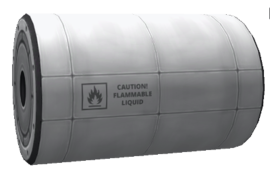Difference between revisions of "Mk1 Liquid Fuel Fuselage"
m (BobBot moved page Mk1 Fuselage - Jet Fuel to Mk1 Liquid Fuel Fuselage: Renamed part after update.) |
m (-version template usage and link directly;) |
||
| Line 13: | Line 13: | ||
== Changes == | == Changes == | ||
| − | ; | + | ;[[0.24]] |
* Dry mass decreased from 0.35 to 0.15 . | * Dry mass decreased from 0.35 to 0.15 . | ||
| − | ; | + | ;[[0.15]] |
* Dry mass increased from 0.3 to 0.35 , fuel system changes reduced full mass from 1.2 to 1.1. | * Dry mass increased from 0.3 to 0.35 , fuel system changes reduced full mass from 1.2 to 1.1. | ||
| − | ; | + | ;[[0.15]] |
* Initial release | * Initial release | ||
{{Parts}} | {{Parts}} | ||
[[Category:Liquid fuel tanks]] | [[Category:Liquid fuel tanks]] | ||
Revision as of 13:24, 3 May 2015
| Mk1 Liquid Fuel Fuselage | ||
| Liquid fuel tank by C7 Aerospace Division | ||
| Radial size | Small, Radial mounted | |
| Cost | (total) | 550.00 |
| (dry) | 230.00 | |
| Mass | (total) | 2.250 t |
| (dry) | 0.250 t | |
| Drag | 0.3-0.2 | |
| Max. Temp. | 2000 K | |
| Impact Tolerance | 10 m/s | |
| Research | | |
| Unlock cost | 2 600 | |
| Since version | 0.15 | |
| Part configuration | mk1Fuselage.cfg | |
| Packed volume | None | |
| Liquid fuel | 400 | |
The Mk1 Fuselage - Jet Fuel is a 1.25 meter “Size 1” fuselage containing only liquid fuel (a.k.a. jet fuel, or kerosene). Like all fuselages, it cannot carry oxidizer. It is not to be confused with the Structural Fuselage which cannot hold fuel or oxidizer.
It and the Structural Fuselage are the only fuselage parts with circular cross-sections. As such, they mate cleanly with Size 1 parts like the FL-T series rocket fuel tanks.
Product description
| “ | A standard fuselage that carries fuel for spaceplanes. This one is chock-full of jet fuel. Not as resistant as it's counterparts, but jet fuel is more efficient than the other fuels, without mentioning lighter. | ” |
Comparisons
With the changes in v0.24, this is now the most efficient jet fuel tank. The total mass is six times the dry mass, out-performing all other means of conveying jet fuel. However, it cannot ever contain oxidizer, meaning it is only useful for atmospheric flight. Its impact tolerance of 20m/s is 3⅓ times greater than the 6m/s typical of rocket and RCS fuel tanks.
Changes
- Dry mass decreased from 0.35 to 0.15 .
- Dry mass increased from 0.3 to 0.35 , fuel system changes reduced full mass from 1.2 to 1.1.
- Initial release
